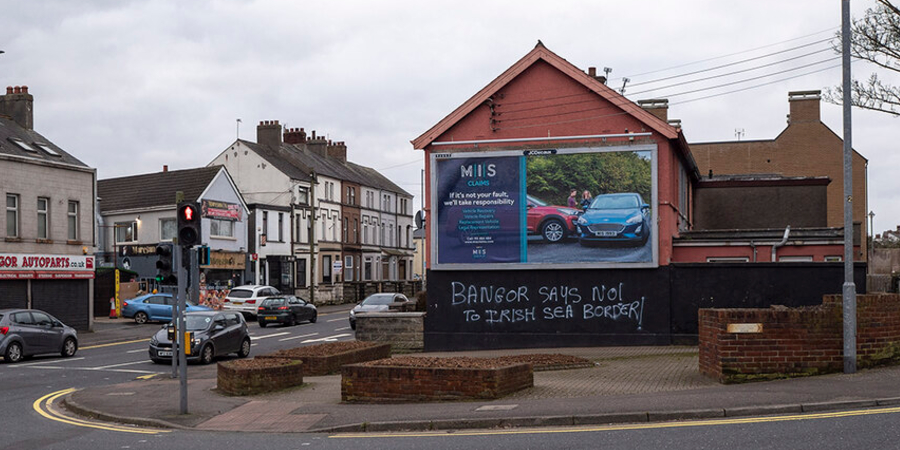Belfast Tinderbox: Why Loyalists Are in the Streets This Spring
Protests and riots in response to the new post-Brexit customs border have raised fears about renewed sectarian violence.

Published by The Lawfare Institute
in Cooperation With

Editor’s Note: The violence that broke out in Northern Ireland earlier this month raised fears that sectarian conflict would return after decades of uneasy peace. American University’s Carolyn Gallaher and Kimberly Cowell-Meyers explain how the latest unrest draws on many of the players during the so-called “Troubles” but that today’s politics, particularly disputes over Brexit, are driving much of the violence.
Daniel Byman
***
On April 7, young people in the Protestant community in the Shankill Road area of Belfast commandeered a bus and set it on fire. Later that night, Protestant and Catholic youth hurled incendiary devices at one another across so-called peace lines—formal and informal barriers that separate places where the two communities border one another. This capped a week of unrest across Northern Ireland. Since the violence started, 88 police officers have been injured.
Violence at interfaces between Protestant and Catholic communities was common during Northern Ireland’s 30-year conflict (1968-1998), known locally as “the Troubles.” The conflict was sectarian and ethno-nationalist. Unionists, who are typically Protestant, believe Northern Ireland should remain part of the United Kingdom. Nationalists, who tend to be Catholic and see themselves as Irish, believe Northern Ireland should be part of the Republic of Ireland. Each side had paramilitaries willing to use violence to pursue their ends. Unionists leaned on loyalist paramilitaries—the Ulster Volunteer Force (UVF) and the Ulster Defence Association (UDA)—while nationalists relied on republican ones—most notably the Provisional Irish Republican Army (IRA).
Low-level street violence has continued in the post-agreement period. These clashes are so common in the summer months that journalists have nicknamed them “recreational rioting.” In May, June, and July, when the sun sets at 11 p.m., teenagers on both sides of the religious divide often gather at hotspots to throw rocks, launch homemade incendiary devices, and yell insults at one another. July is especially intense due to unionist commemorations of Protestant victories in the 17th century.
The recent violence looks similar, but two things set it apart. First, violence has been concentrated in loyalist communities, and second, it is broadly connected to loyalist paramilitaries’ recent rejection of the Good Friday Agreement (GFA), which formally ended the Troubles 23 years ago. The GFA created a power-sharing government between unionists and nationalists, among other structural reforms. This spring’s conflagration is the result of fallout from Brexit overlapping with the continuing influence of paramilitaries despite the Good Friday Agreement.
The Northern Ireland Protocol
Commentators warned that Brexit would destabilize the peace process, and it did. It is difficult to know if unionists, who overwhelmingly supported leaving the European Union, were engaged in magical thinking when they insisted Brexit wouldn’t undermine the GFA, or if they were calculating that Brexit would strengthen their hand against nationalists. In the end, the Northern Ireland Protocol, which lays out the post-Brexit ground rules governing trade between the U.K. and the Republic of Ireland, did not favor unionist interests.
During negotiations, a key sticking point was where to place the border for customs checks. The EU vigorously opposed reestablishing a land border between the Republic of Ireland and Northern Ireland. During the Troubles, the border had been heavily militarized, and guard posts were often subjected to attacks from the IRA. After the GFA, border infrastructure was dismantled and the border virtually disappeared. Because both countries were part of the EU, people and goods could cross the border without passport or customs checks. This contributed to peace-building by encouraging economic development throughout the island and neutralizing the border issue as a source of conflict between the competing identities of nationalists and unionists.
Post-Brexit, there were two ways to avoid reinstating a hard border between the Republic of Ireland and Northern Ireland. One option was for the U.K. to leave the EU but remain in its customs union (similar to Norway’s status). Unionist parties in Northern Ireland and the Conservatives in the U.K. repeatedly rejected this option, arguing that staying in the customs union was not a real exit from the EU. The second option was to put a border in the Irish Sea so that goods coming into Northern Ireland from Great Britain could move into the Republic of Ireland without stopping at the land border between them. Unionists in Northern Ireland voiced strenuous opposition to this plan.
Although he promised not to put the border in the Irish Sea, British Prime Minister Boris Johnson ultimately did just that. Implementation began in December 2020. The EU had long resisted Johnson’s entreaties for flexibility, arguing that it would not be party to undermining the GFA. Its message was reinforced by the Police Service of Northern Ireland and the New IRA, a dissident republican group, which told a broadcaster in October 2019 that it would consider border infrastructure “a legitimate target for attack.”
The result is that goods coming from cities like Liverpool to Belfast now have to go through customs checks in the port of Belfast, even though both cities are part of the same country.
To unionists, the creation of a trade barrier between Northern Ireland and the rest of the U.K. looks like de facto unification with the Republic of Ireland. To loyalists, it also looks like British capitulation in the face of potential republican violence if the land border were restored. In Northern Ireland’s zero-sum politics, loyalists now believe they have license to use the threat of violence, just as they perceive republicans did during protocol negotiations. In early March, the Loyalist Communities Council, which represents loyalist paramilitary factions, issued a statement announcing it was withdrawing its support for the GFA.
Persistent Paramilitarism
Many commentators believe paramilitaries are behind the recent wave of violence. On Twitter, locals pointed to video footage of young kids appearing to take directions from adults on the scene. Others note that paramilitaries have often stage-managed street protests.
Leaders of the Loyalist Communities Council have denied involvement, and the police have backed them up, announcing they had no evidence paramilitaries “sanctioned and organized” the violence.
Debating whether paramilitaries stage-managed the rioting misses two larger points, however. First, even if the paramilitaries did not direct the recent violence, they were willing to use it to hammer home a political point. In the same statement in which the Loyalist Communities Council disavowed involvement in the riot, for example, it also declared the protocol was a “spectacular collective failure” that was bound to lead to violence. In paramilitary strongholds, paramilitaries have the power to shape the perception of events, even those they don’t initiate or control.
Second, why are paramilitaries still powerful 23 years after the GFA. Republican and loyalist paramilitaries eventually decommissioned their weapons and stood down active units (the IRA in 2005, the UVF and the UDA in 2007), but they didn’t go away. On the republican side, dissident republican paramilitaries replaced the IRA. On the loyalist side, the UVF and the UDA simply stayed put and continued to recruit. The Police Service of Northern Ireland estimates that loyalist paramilitaries currently have as many as 12,500 members.
But loyalist groups aren’t as cohesive or disciplined as they were during the Troubles (and even then, they weren’t as disciplined or cohesive as the IRA). Over time, centralized command structures have weakened. Many units operate semiautonomously. When commanders want to exert power over wayward factions, they have to consider the risks. During the early 2000s, loyalist attempts to police their own led to a series of deadly feuds, as the saga of Johnny Adair demonstrated. In 2000 Adair, who commanded an Ulster Defence Association faction, sparked a bloody, months-long feud with the Ulster Volunteer Force leadership when he teamed up with a UVF splinter group to sell drugs in UVF territory. Several people were killed, and hundreds of families seen as aligned with the UVF were displaced from their homes in Adair’s turf.
As a result, many of the old guard, who negotiated the 1994 cease-fires and the 1998 peace accord, have been sidelined. Indeed, a division of labor has emerged within loyalist paramilitaries. The old guard often engages in street-level peace-making, deconflicting between local factions, helping young people find job training and negotiating alternatives for people facing paramilitary rough justice. Newer leaders—many born in the 1990s—have taken the reins of burgeoning criminal enterprises, selling drugs and extorting local businesses.
“Pop-up gangs” are also in the mix. These are often small groups of young men who occasionally coordinate with paramilitary leaders for protests or riots, but they aren’t beholden to or controlled by them. Coronavirus-related restrictions and the announcement on March 30 by the Public Prosecution Service that no one would be prosecuted for attending IRA leader Bobby Storey’s funeral last June when public gatherings were banned have created a reservoir of frustration seeking catharsis.
Although many paramilitary men aren’t interested in politics, the UVF and UDA names come with a built-in political history. Often, this history affords political legitimacy for their criminal activity. But the disruptions caused by the protocol, and the sense it creates among unionists that they lost an important battle, means paramilitary men can’t ignore it. Indeed, in poor and working-class neighborhoods where trust in politicians is low, many people expect paramilitaries to speak for them, even if they don’t like them very much.
The question is which part of loyalism will set strategy and tactics moving forward. The Loyalist Communities Council, which is staffed largely by old-guard loyalists, claims it doesn’t condone or want the violence. Criminal elements, by contrast, may welcome the diversion it creates from their illicit activities. And it’s not clear what the youth will choose.
It may be difficult to stem the violence if its perpetrators see it as useful and there is no leadership to control it. There is little room for the British government to concede to unionist/loyalist demands on the protocol. And, unfortunately, policing alone won’t solve this problem. The political and social dimensions underlying the recent violence will ultimately have to be addressed by the unionist and loyalist communities.






